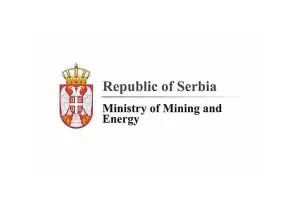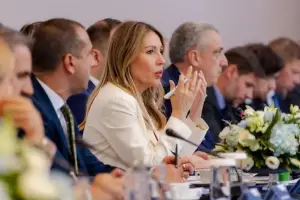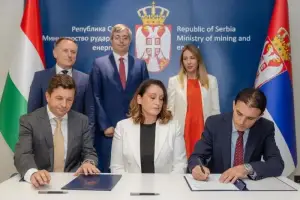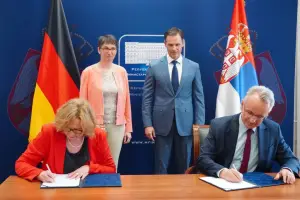Q:
A:
38.8% growth in Serbia’s foreign trade from January to November
Belgrade,
27 December 2007
The Serbian Statistics Office stated today that the total worth of Serbia’s foreign trade from January to November this year was $24,419.8 million which shows a growth of 38.8% against the same period in 2006. Expressed in euros this figure is €17,902.1 million or 27.5% more than the same period in 2006.
Goods worth $7,982.4 million were exported, which is a growth of 38.1% against the same period in 2006. Goods worth $16,437.4 million were imported, which is 39.2% more against the same period in 2006.
Exports, expressed in euros, imports were worth €5,854.8 million, which is an increase of 26.9% against the same period in 2006. Imports were worth €12,047.3 million, which is an increase of 27.8% against the same period in 2006.
Trade deficit stood at $8,454.9 million and is larger by 40.3% against the same period in 2006. Expressed in euros the deficit stands at €6,192.4 million, which is an increase of 28.6% against the same period in 2006.
The export to import ratio stood at 48.6%, showing an insignificant increase compared to the same period in 2006, when it was 49%, as a result of faster increase in imports during the previous two months.
Increase of imports in the pervious period was a result of importing energy, which in the previous period was 17.2% of total imports, and copper and iron ores import.
Increase in exports resulted from privatisation and restructuring of companies accomplished until now, as well as signed and ratified agreements on free trade with countries signatory to the Stability Pact, which are now unified under the single Central European Free Trade Agreement. This was also due to export of surplus agricultural produce, which for fruits and vegetables was worth $433 million, for food grains and related products $318 million. The agreement signed with the EU according to which Serbian textile products are given preferential status on the EU market also influenced this increase.
Regarding the structure of exports, the most notable were: reproduction products 66.4% ($5300.2 million), then consumer goods 26.8% ($2.137.0 million) and equipment 6.8% ($545.2 million).
Regarding the structure of imports the most notable were: reproduction products 61.1% ($10,041.9 million), then consumer goods 21.7% ($3.560.4 million) and equipment 17.2% ($2.835 million).
Major foreign trade partners in exports in the reference period were: Italy ($1,002.8 million), Germany ($859.2 million) and Bosnia-Herzegovina ($951.4 million).
Major foreign trade partners in imports in the reference period were: the Russian Federation ($2,328 million), Germany ($1,925.7 million) and Italy ($1,588 million).
Largest trade was with EU countries, accounting for more than half of total foreign trade.
Surplus was realised in trade with Bosnia-Herzegovina, Montenegro, Macedonia.
The largest deficit was in trade with Russia due to import of energy, above all gas and oil and inadequate utilisation of the free trade agreement by Serbian importers.
According to the divisions of the Standard International Trade Classification (SITC) the following items had the greatest export share: iron and steel ($1,020 million), coloured metals ($647 million), vegetables and fruits ($433 million), clothes ($405 million), metal products ($387 million). These five sections accounted for 36.2% of overall exports.
The first five divisions with the greatest imports share were the following: oil and oil derivatives ($1,756 million), road vehicles ($1,352 billion), industrial machines for general use ($789 million) and iron and steel ($845 million), electric machines and equipment ($705 million) and these accounted for 33.1% of overall imports.
The list of the first 100 products in export and imports for November was significantly different from the previous month.
Among the first 100 products in exports, at the top were refined sugar ($20.7 million) followed by pneumatic tires for cars (more than $17.1 million).
Among the first 100 products in imports, at the top was oil ($150.2 million), gas ($73.7 million) and cars ($56.2 million).
Exports, expressed in euros, imports were worth €5,854.8 million, which is an increase of 26.9% against the same period in 2006. Imports were worth €12,047.3 million, which is an increase of 27.8% against the same period in 2006.
Trade deficit stood at $8,454.9 million and is larger by 40.3% against the same period in 2006. Expressed in euros the deficit stands at €6,192.4 million, which is an increase of 28.6% against the same period in 2006.
The export to import ratio stood at 48.6%, showing an insignificant increase compared to the same period in 2006, when it was 49%, as a result of faster increase in imports during the previous two months.
Increase of imports in the pervious period was a result of importing energy, which in the previous period was 17.2% of total imports, and copper and iron ores import.
Increase in exports resulted from privatisation and restructuring of companies accomplished until now, as well as signed and ratified agreements on free trade with countries signatory to the Stability Pact, which are now unified under the single Central European Free Trade Agreement. This was also due to export of surplus agricultural produce, which for fruits and vegetables was worth $433 million, for food grains and related products $318 million. The agreement signed with the EU according to which Serbian textile products are given preferential status on the EU market also influenced this increase.
Regarding the structure of exports, the most notable were: reproduction products 66.4% ($5300.2 million), then consumer goods 26.8% ($2.137.0 million) and equipment 6.8% ($545.2 million).
Regarding the structure of imports the most notable were: reproduction products 61.1% ($10,041.9 million), then consumer goods 21.7% ($3.560.4 million) and equipment 17.2% ($2.835 million).
Major foreign trade partners in exports in the reference period were: Italy ($1,002.8 million), Germany ($859.2 million) and Bosnia-Herzegovina ($951.4 million).
Major foreign trade partners in imports in the reference period were: the Russian Federation ($2,328 million), Germany ($1,925.7 million) and Italy ($1,588 million).
Largest trade was with EU countries, accounting for more than half of total foreign trade.
Surplus was realised in trade with Bosnia-Herzegovina, Montenegro, Macedonia.
The largest deficit was in trade with Russia due to import of energy, above all gas and oil and inadequate utilisation of the free trade agreement by Serbian importers.
According to the divisions of the Standard International Trade Classification (SITC) the following items had the greatest export share: iron and steel ($1,020 million), coloured metals ($647 million), vegetables and fruits ($433 million), clothes ($405 million), metal products ($387 million). These five sections accounted for 36.2% of overall exports.
The first five divisions with the greatest imports share were the following: oil and oil derivatives ($1,756 million), road vehicles ($1,352 billion), industrial machines for general use ($789 million) and iron and steel ($845 million), electric machines and equipment ($705 million) and these accounted for 33.1% of overall imports.
The list of the first 100 products in export and imports for November was significantly different from the previous month.
Among the first 100 products in exports, at the top were refined sugar ($20.7 million) followed by pneumatic tires for cars (more than $17.1 million).
Among the first 100 products in imports, at the top was oil ($150.2 million), gas ($73.7 million) and cars ($56.2 million).










